
From Baby to Adult: Stages of a Bearded Dragon’s Life Cycle
Introduction to Bearded Dragons:
Bearded dragons, scientifically known as Pogona vitticeps, have become one of the most popular reptile pets globally. Their docile nature, vibrant colors, and relatively easy care make them ideal for both novice and experienced reptile enthusiasts. These lizards originate from the arid regions of Australia, where they thrive in warm, dry climates. As pets, they require specific environmental conditions and a balanced diet to ensure their health and longevity.
Bearded dragons are named for the spiky scales along their throat, which they can puff out to appear larger when threatened, resembling a beard. They are known for their friendly demeanor and are often described as being quite interactive with their human companions. With proper care, these fascinating creatures can live up to 10 years or more in captivity.
Baby Stage: The Early Years
The baby stage of a bearded dragon’s life is marked by rapid growth and development. Newborn bearded dragons are typically around 3 to 4 inches long, excluding their tail. Their small size makes them particularly vulnerable, requiring careful attention to their environment and diet.
Diet: Babies need a diet rich in calcium and protein to support their rapid bone growth. They primarily eat insects like crickets and mealworms, which should be dusted with calcium powder to prevent metabolic bone disease. Introducing leafy greens, such as collard greens and dandelion leaves, can also be beneficial but should be limited initially to avoid digestive issues.
Care Requirements: Housing for baby bearded dragons should be spacious enough to allow movement but not so large that they feel exposed. A 20-gallon tank is generally sufficient for babies, with a secure screen top to maintain temperature and humidity levels. The enclosure must include a heat gradient, with one side reaching around 95°F (35°C) and the cooler side at about 85°F (29°C). UVB lighting is crucial for vitamin D synthesis, promoting healthy calcium absorption.
Juvenile Stage: Growth and Development
As bearded dragons enter the juvenile stage, usually between 2 to 6 months old, they experience significant growth. Juveniles can grow up to 12 inches in length and develop more pronounced spikes along their body. During this phase, their behavior becomes more active, and they start exploring their surroundings more confidently.
Growth Patterns: Juveniles continue to grow rapidly, increasing their body mass and length. They require higher caloric intake to fuel this growth, including a mix of insects and occasional plant matter. The frequency of feeding increases, with multiple small meals per day.
Nutritional Needs: Juveniles benefit from a varied diet that includes a wider range of insects, such as dubia roaches and super worms, in addition to crickets. The calcium supplementation should still be provided, but it can be gradually reduced as the lizard matures. Additionally, introducing more vegetables, such as squash and carrots, helps meet their growing nutritional needs.
Adult Stage: Maturity and Maintenance
By the time bearded dragons reach adulthood, usually around 8 to 12 months, they have reached their full-grown size, typically between 16 to 24 inches in length. At this stage, they are less active and spend more time basking and digesting food.
Full-Grown Size: Adult bearded dragons exhibit distinct physical characteristics, with males being slightly larger than females. They have fully developed spikes and a robust appearance. Their coloration may vary depending on their environment and mood, ranging from bright oranges and reds to darker browns.
Dietary Adjustments: Adult bearded dragons can consume a more diverse diet, including leafy greens, vegetables, fruits, and insects. However, the proportion of insects in their diet should decrease, as too much protein can lead to obesity and other health issues. Instead, vegetables should form the bulk of their diet, with insects serving as occasional treats.
Maintenance: Adult bearded dragons require a larger enclosure, ideally a 40-gallon tank or larger, to accommodate their size and provide ample space for exercise. The temperature gradient remains important, with a hot spot reaching 100°F (38°C) and a cool side at around 80°F (27°C). Regular cleaning of the enclosure is necessary to maintain hygiene and prevent infections.
Lifelong Care and Health Issues
Proper care throughout a bearded dragon’s life cycle is essential for their well-being. Lifelong care involves maintaining optimal environmental conditions, providing a balanced diet, and regular health check-ups.
Tips for Lifelong Care:
- Ensure consistent access to UVB lighting and a heat source to promote healthy skin and digestion.
- Monitor weight and adjust feeding habits accordingly to prevent obesity.
- Provide mental stimulation through toys and varied environments to keep them engaged.
Common Health Issues:
- Metabolic Bone Disease (MBD): Caused by insufficient calcium intake or lack of UVB light, leading to weak bones and deformities.
- Impaction: Occurs when substrate or undigested food blocks the digestive tract, causing lethargy and loss of appetite.
- Respiratory Infections: Indicated by wheezing, nasal discharge, and lethargy, often due to poor ventilation or incorrect temperatures.
Regular veterinary check-ups and prompt treatment of any health issues are crucial for ensuring your bearded dragon enjoys a long and healthy life.
Conclusion:
Understanding the different stages of a bearded dragon’s life cycle is vital for providing appropriate care and ensuring their well-being. From the tiny, fragile babies to the robust adults, each stage presents unique challenges and opportunities for enrichment. By offering a balanced diet, suitable housing, and attentive care, you can help your bearded dragon thrive and enjoy a fulfilling life as a cherished pet.




